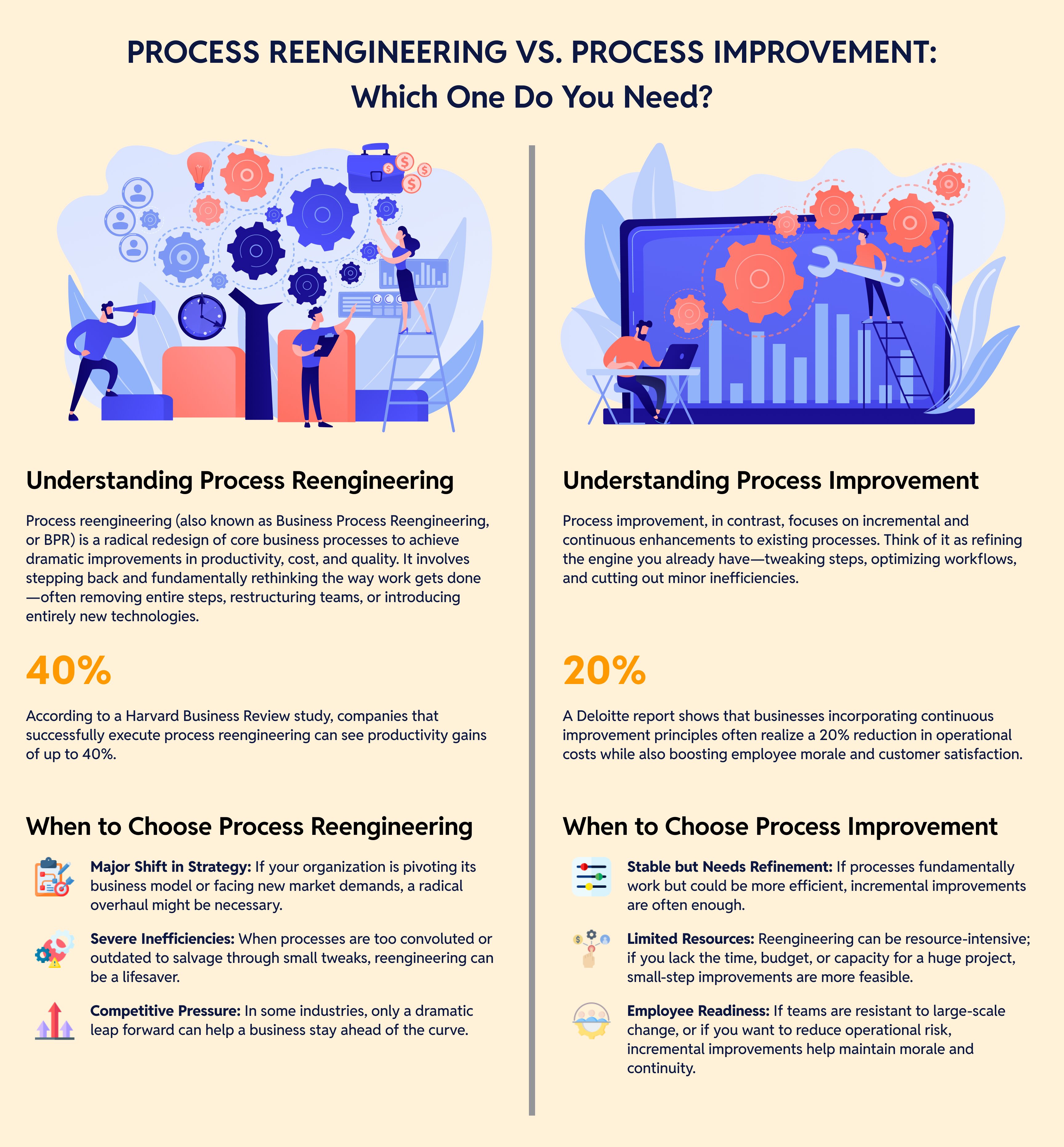Modern businesses are constantly challenged to stay efficient and responsive in a competitive market. As organizations evolve, processes can become outdated, creating inefficiencies and barriers to growth. But how should a company tackle these problems—through gradual improvements or a complete overhaul of its processes? This is the core difference between process reengineering and process improvement. Choosing the right approach can make the difference between slow incremental gains and radical, game-changing transformation.
In this article, we’ll clarify the differences between process reengineering and process improvement, explore when to apply each method for maximum impact, and show how XMC360 provides the tools and insights to make the right call.



Understanding Process Reengineering
Process reengineering (also known as Business Process Reengineering, or BPR) is a radical redesign of core business processes to achieve dramatic improvements in productivity, cost, and quality. It involves stepping back and fundamentally rethinking the way work gets done—often removing entire steps, restructuring teams, or introducing entirely new technologies.
- Scope and Scale: Typically large, organization-wide projects that can disrupt multiple departments.
- Objective: Achieve breakthrough results, such as a 50–80% decrease in process time or cost.
- Risk Factor: High. If not planned and executed well, the scale of changes can cause confusion, adoption issues, and employee resistance.
According to a Harvard Business Review study, companies that successfully execute process reengineering can see productivity gains of up to 40%1. However, the same study notes that poor planning and lack of stakeholder buy-in often lead to stalled implementations or partial rollouts—diminishing the potential for truly transformative outcomes.
Understanding Process Improvement
Process improvement, in contrast, focuses on incremental and continuous enhancements to existing processes. Think of it as refining the engine you already have—tweaking steps, optimizing workflows, and cutting out minor inefficiencies.
- Scope and Scale: Smaller, targeted projects that tackle specific performance issues.
- Objective: Achieve incremental but sustainable gains, often 10–30% improvements in speed, quality, or cost.
- Risk Factor: Lower. Gradual enhancements are typically easier for employees to adopt, though results might not be as dramatic.
A Deloitte report shows that businesses incorporating continuous improvement principles often realize a 20% reduction in operational costs while also boosting employee morale and customer satisfaction2. Because changes are incremental, teams can adapt more comfortably, iterating and refining as they go.

When to Choose Process Reengineering
- Major Shift in Strategy: If your organization is pivoting its business model or facing new market demands, a radical overhaul might be necessary.
- Severe Inefficiencies: When processes are too convoluted or outdated to salvage through small tweaks, reengineering can be a lifesaver.
- Competitive Pressure: In some industries, only a dramatic leap forward can help a business stay ahead of the curve.
Example: A manufacturing company experiences chronic bottlenecks that add days to product delivery. Incremental fixes haven’t moved the needle enough, so leadership opts for a radical redesign—centralizing all scheduling, automating major production steps, and restructuring the warehouse layout.

When to Choose Process Improvement
- Stable but Needs Refinement: If processes fundamentally work but could be more efficient, incremental improvements are often enough.
- Limited Resources: Reengineering can be resource-intensive; if you lack the time, budget, or capacity for a huge project, small-step improvements are more feasible.
- Employee Readiness: If teams are resistant to large-scale change, or if you want to reduce operational risk, incremental improvements help maintain morale and continuity.
Example: A mid-sized retail chain has a well-functioning supply chain but wants to cut delivery times by 15%. Through process mapping and small technology upgrades, they systematically reduce order-to-shelf delays without overhauling the entire system.
How XMC360 Helps You Decide—and Execute
At XMC360, we recognize that no two organizations are alike. Whether you need a radical transformation or incremental tweaks, our platform provides:
Advanced Process Mapping & Analytics
Visualize existing workflows, spot inefficiencies in real time, and quantify the potential ROI of each approach.
Stakeholder Collaboration
Involve key decision-makers early, capturing input from operations, finance, and customer service. This ensures buy-in and supports smoother implementation.
Scalable Solutions
Start with small improvements if needed, then easily transition to larger reengineering projects. XMC360’s flexible architecture adapts to your unique operational scale.
Continuous Feedback Loop
Monitor outcomes, measure KPIs (like cycle time or cost savings), and refine strategies based on real-world results.
Whether you’re aiming for a breakthrough leap or steady progress, XMC360 gives you the visibility and control to choose—and successfully follow through on—the right path.

Process reengineering can deliver dramatic improvements but comes with higher risk and investment, while process improvement offers steady, incremental gains that are often easier for teams to adopt. Picking the right method is crucial for achieving your goals without wasting resources or overwhelming employees.
At XMC360, we help organizations diagnose their current state, analyze potential ROI, and guide them toward the right solution—whether it’s a radical overhaul or continuous fine-tuning. Ready to unlock new levels of operational efficiency? Connect with us today to explore how XMC360 can support your journey, from planning to implementation and beyond.
References:
- Harvard Business Review. (2019). Reinventing the Organization: How Companies Can Deliver Radically Greater Value in Fast-Changing Markets.
- Deloitte. (2021). Operational Excellence: Trends in Continuous Improvement.


